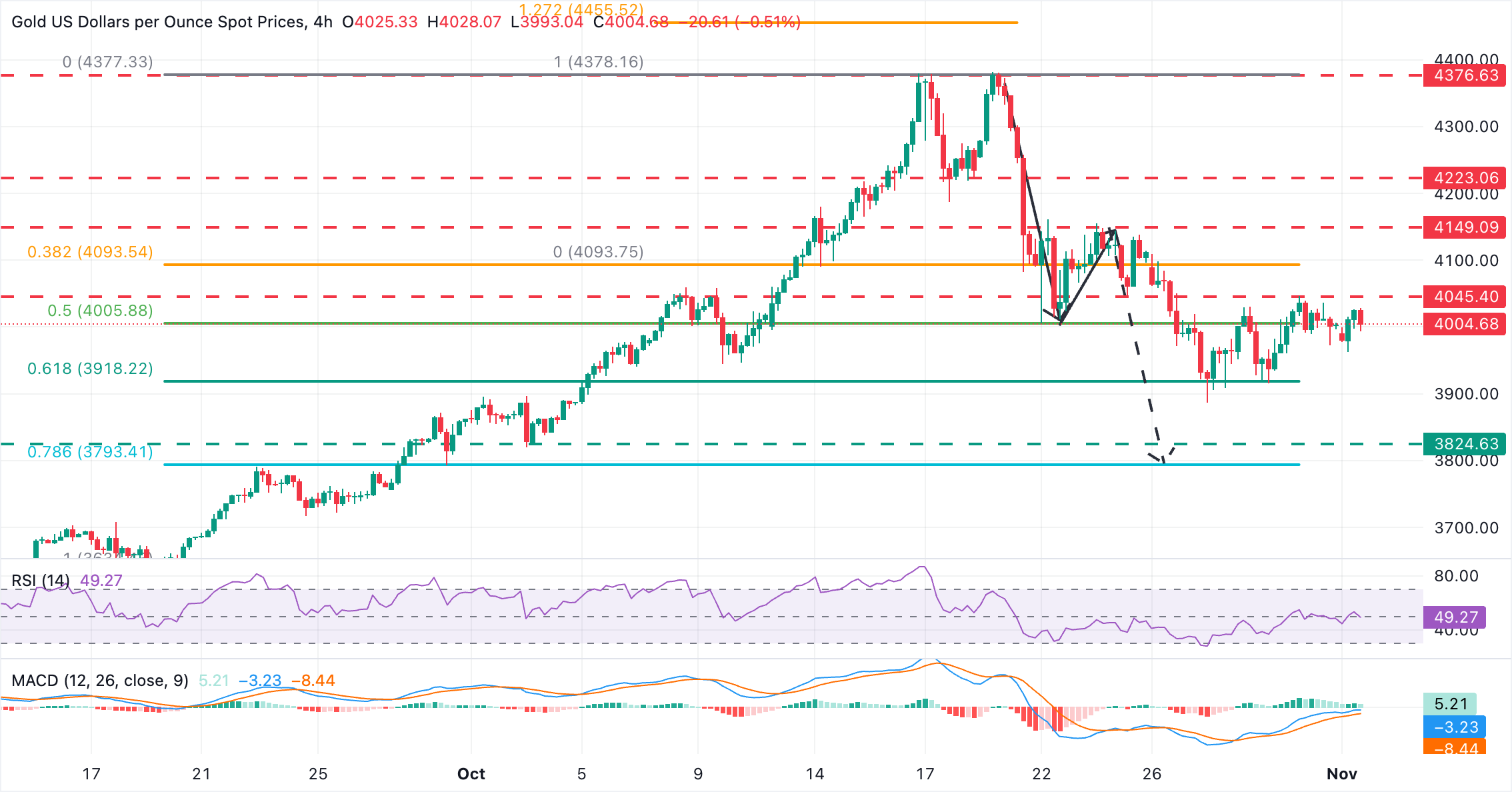Gold Price Forecast: Bulls remain capped below $4,045 resistance
- Gold attempts to bounce up from lows below $3,900 remains capped at $4,045 area
- US Dollar's strength following the Fed's hawkish stance is weighing on precious metals' recovery.
- Failure to breach $4,045 resistance area leaves the $3,900 support exposed.
Gold (XAU/USD) has bounced from last week's lows below the $3,900 level, yet bulls remain unable to confirm above a previous support area around $4,045 (October 24 low), which leaves price action fluctuating without a clear bias around the $4,000 level on Monday,, with investors awaiting US manufacturing data due later on the day,.
Looking from a wider perspective, the precious metal remains on the back foot, as the US Dollar retraces previous losses, buoyed by the Fed's monetary policy stance. The US central bank cut rates, as expected last week, but Chairman Powell warned about excessive confidence in further monetary easing in December, which sent US treasury yields rallying and the US Dollar higher with them.
Technical Analysis: Support at $3,900 area remains in play

The technical perspective shows a mixed picture, with the 4-hour Relative Strength Index (RSI) hovering around the 50 level, highlighting a stalled market. Bulls are failing to breach the resistance area between $4,030 and $4,045 (October 29, 31 highs), which leaves the support area around $3,900 exposed.
A confirmation above the $4,045 level is needed to ease bearish pressure and put some distance from last week's lows. That would shift the focus towards the $4,150 area (October 23 highs). Further up, the next target would be a previous support area ahead of $4,220, which contained bears on October 17, 19, and 20.
To the downside, a further decline below the October 28 low, near $3,890, would bring the October 2 low near $3,820 into focus. That level is a few pips above the measured target of an A-B=C-D retracement from $4,370 highs, which lies at $3,795.
Gold FAQs
Gold has played a key role in human’s history as it has been widely used as a store of value and medium of exchange. Currently, apart from its shine and usage for jewelry, the precious metal is widely seen as a safe-haven asset, meaning that it is considered a good investment during turbulent times. Gold is also widely seen as a hedge against inflation and against depreciating currencies as it doesn’t rely on any specific issuer or government.
Central banks are the biggest Gold holders. In their aim to support their currencies in turbulent times, central banks tend to diversify their reserves and buy Gold to improve the perceived strength of the economy and the currency. High Gold reserves can be a source of trust for a country’s solvency. Central banks added 1,136 tonnes of Gold worth around $70 billion to their reserves in 2022, according to data from the World Gold Council. This is the highest yearly purchase since records began. Central banks from emerging economies such as China, India and Turkey are quickly increasing their Gold reserves.
Gold has an inverse correlation with the US Dollar and US Treasuries, which are both major reserve and safe-haven assets. When the Dollar depreciates, Gold tends to rise, enabling investors and central banks to diversify their assets in turbulent times. Gold is also inversely correlated with risk assets. A rally in the stock market tends to weaken Gold price, while sell-offs in riskier markets tend to favor the precious metal.
The price can move due to a wide range of factors. Geopolitical instability or fears of a deep recession can quickly make Gold price escalate due to its safe-haven status. As a yield-less asset, Gold tends to rise with lower interest rates, while higher cost of money usually weighs down on the yellow metal. Still, most moves depend on how the US Dollar (USD) behaves as the asset is priced in dollars (XAU/USD). A strong Dollar tends to keep the price of Gold controlled, whereas a weaker Dollar is likely to push Gold prices up.

